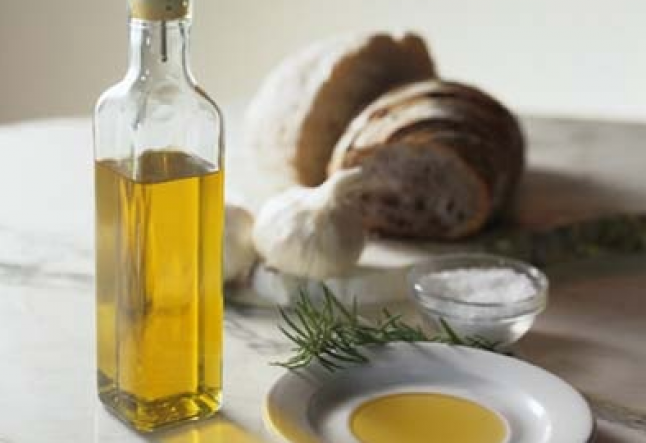essential culinary oils

Thanks to widespread interest in heart-healthy cuisine, international flavors and the increasing affordability of extra virgin olive oils, many of us are using specialty oils in ways our mothers would have never dreamt. But there are many more oils to enjoy than olive oil, observes Charles Hechinger, executive chef at the Claremont Resort & Spa in Berkeley, CA.
To get started, says Chef Hechinger, “Stock organic extra virgin oil, cold pressed hazelnut oil and walnut oils, a fine grapeseed oil and a good sesame oil.” Hechinger notes that good, quality olive and nut oils are made from the first cold press. “Check labels before buying,” he says. “There is a considerable flavor difference between artisanal and mass-produced oils because of the care taken in producing artisanal oils. Artisanal oils are produced in limited amounts with a very strong commitment to pure, raw product in order to ensure impeccable quality.”
Delicious and affordable oils include Trader Joe’s Extra Virgin Olive Oil and Whole Foods’ house brand 365. For autumn and winter, Chef Hechinger suggests using organic pumpkin oil in butternut squash pastas, pumpkin soups, salad dressings, and roasted vegetable dishes.
While white truffle oil is Hechinger’s favorite for flavoring pastas, potatoes, Porcini carpaccio, risottos and more, he also recommends organically derived oils for their culinary and environmental merits. “Organically derived oils embody vast differences in flavor due to their superior cultivation and production,” he explains. “From an environmental and health point of view, it’s best to support sustainable agriculture whenever possible as it promotes a less toxic planet and a cleaner, healthier food source for us all,” he adds. “One thing I want to stress about organic oils is that because their quality and flavor is so superb, only small amounts are needed, so they work out to be extremely economical to use.”
One of the best, nationally available manufacturers of healthy oils is Spectrum Organics. This company’s mission is to make healthy oils and healthy fats available to the public. Whether artisan olive oils and trans-fat free spreads, or super-healthy, anti-inflammatory supplements like Flax Oil, Spectrum organic oils are all delicious and worth experimenting with in your salads, soups and main courses. Their Web site offers extensive guidelines on various oils and how-tos on using them in salads and cooked meals. On the Spectrum site, you will also find hundreds of low-fat, gourmet recipes for snacks, main dishes and even three course meals.
Regarding diet oils for those who are calorie-conscious, the new cooking oil Enova TM may be worth trying. Full disclosure: Enova is a synthesized oil cooked up in the laboratory from soy and canola oils, meaning Enova is not found in nature. Its merits as a weight loss tool, however, may offset its synthetic aspects. “When used as part of a calorie-controlled diet, it has been clinically shown that compared to other cooking and salad oils, less of Enova is stored in the body as fat,” says Kevin Maki, Ph.D., a researcher who has studied the oil. Enova is available nationally in supermarkets..
No discussion of culinary oils is complete without mentioning the virtues of coconut oil. After years of being misunderstood by consumers, coconut oil is fast emerging as a much-loved and healthy oil. According to Theresa Dale, Ph.D., C.C.N. (certified clinical nutritionist) and founder of the California College of Natural Medicine in Santa Cruz, CA, these are some of the benefits of coconut oil: “Research has shown that the saturated fat in coconut oil is far more healthful for you than the kind found in animal fats. Natural coconut fat in the diet leads to a normalization of body lipids (or body fats), protects against alcohol damage to the liver and improves the immune system’s anti-inflammatory response.” Dr. Dale also says that you can use coconut oil to cook or sauté. “Consuming coconut oil is an easy way to upgrade your health while enjoying a delicious oil.”
In conclusion, when experimenting with culinary oils, it is always wise to remember that less is more. Start out using tiny amounts if you are not sure about how intense the flavors may taste. For example, a dash of white truffle oil stirred in before serving imbues pasta and risottos with a bona fide, earthy, European flavor, while EFA-rich Moroccan argan oil has been used for millennia to add savory, North African intensity to lentil and salad dishes.
Read next >> organic gemini tigernut horchata